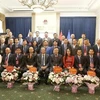A national report on Vietnamese youth, the first of its kind in Vietnam, is expected to be announced in 2015, said Vu Dang Minh, head of the Department of Youth Affairs at the Ministry of Home Affairs.
The report aims to assess the real conditions of education, employment and health care of the youth, while review related policies to give necessary recommendations, he told domestic and foreign experts at a conference to collect comments to the draft report held in the northern Quang Ninh province on December 1.
The report is expected to provide specific data and an overall look onto Vietnamese youth, laying foundation for research, and making, carrying out and overseeing the implementation of policies relating to the youth, he said.
The report uses statistics of previous national research and surveys, including the 2009 Vietnam population and housing census, the survey assessment on Vietnamese youth round 2 (SAVY2), the 2010 Vietnam’s multiple indicator cluster survey (MICS), and the 2013 survey on labour and job by the General Statistic Office, said Minh.
UNFPA Deputy Representative in Vietnam Ritsu Nacken said Vietnam currently has a “golden population structure” with the highest ratio of youngsters in the history.
The number of people aged from 10-24 account for nearly 40 percent of the country’s population, she noted, asserting that the period will remain until 2040.
This is a great chance for Vietnam to boost its socio-economy and utilise its potential by promoting the role of the youth, she commented.
The report will help figure out gaps in Vietnam’s current policies on the youth as well as the implementation of support policies in education, health care and employment, said Nacken.
She also lauded the initiative of making a report on Vietnamese youth, pledging that the UNFPA will closely coordinate with and support Vietnam during the process of drafting and completing the report.
Meanwhile, Dr. Tran Van Mieu, Director of the Centre for Education, Environment and Development Research, said the report needs to give comprehensive and in-depth assessments on the real situation of Vietnamese youth.
It should gather updated data and information on the youth, thus recommending effective and feasible solutions, he said.
Nguyen Bich Diem, Vice Director of the Institute of Youth Research, emphasised the need to analyse the data and real situation to make specific and accurate evaluations as well as recommendations and orientations.-VNA
The report aims to assess the real conditions of education, employment and health care of the youth, while review related policies to give necessary recommendations, he told domestic and foreign experts at a conference to collect comments to the draft report held in the northern Quang Ninh province on December 1.
The report is expected to provide specific data and an overall look onto Vietnamese youth, laying foundation for research, and making, carrying out and overseeing the implementation of policies relating to the youth, he said.
The report uses statistics of previous national research and surveys, including the 2009 Vietnam population and housing census, the survey assessment on Vietnamese youth round 2 (SAVY2), the 2010 Vietnam’s multiple indicator cluster survey (MICS), and the 2013 survey on labour and job by the General Statistic Office, said Minh.
UNFPA Deputy Representative in Vietnam Ritsu Nacken said Vietnam currently has a “golden population structure” with the highest ratio of youngsters in the history.
The number of people aged from 10-24 account for nearly 40 percent of the country’s population, she noted, asserting that the period will remain until 2040.
This is a great chance for Vietnam to boost its socio-economy and utilise its potential by promoting the role of the youth, she commented.
The report will help figure out gaps in Vietnam’s current policies on the youth as well as the implementation of support policies in education, health care and employment, said Nacken.
She also lauded the initiative of making a report on Vietnamese youth, pledging that the UNFPA will closely coordinate with and support Vietnam during the process of drafting and completing the report.
Meanwhile, Dr. Tran Van Mieu, Director of the Centre for Education, Environment and Development Research, said the report needs to give comprehensive and in-depth assessments on the real situation of Vietnamese youth.
It should gather updated data and information on the youth, thus recommending effective and feasible solutions, he said.
Nguyen Bich Diem, Vice Director of the Institute of Youth Research, emphasised the need to analyse the data and real situation to make specific and accurate evaluations as well as recommendations and orientations.-VNA



















